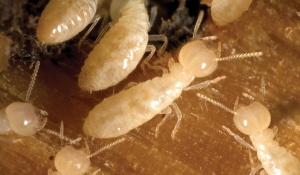Termites in forestry / Mối trong lâm nghiệp
Termites can have a significant impact on plantation and urban forestry, as well as on agricultural tree crops. Many other insect pest species cause damage to various parts of the tree, but often do not cause mortality. Even where termites do not cause death of the tree, they may cause damage to the bole, for example, by consuming the heartwood and, thereby, hollowing the trunk and reducing the value of the tree as a source of timber. There are a number of current chemical control methods employe
 d, namely fipronil; imidacloprid; chorfenapyr have proven to be an excellent control product.
d, namely fipronil; imidacloprid; chorfenapyr have proven to be an excellent control product.
Mối có thể có tác động đáng kể đến nông trại và lâm nghiệp, cũng như cây trồng nông nghiệp. Nhiều loài côn trùng gây hại khác gây thiệt hại cho nhiều bộ phận khác nhau của cây nhưng thường không gây chết cây. Ngay cả khi mối mọt không làm chết cây, chúng vẫn có thể gây hư hại cho thân cây, ví dụ, bằng cách ăn lõi gỗ và do đó làm rỗng thân cây và làm giảm giá trị nguồn gỗ của cây. Có một số phương pháp kiểm soát hóa học hiện nay được sử dụng, cụ thể là fipronil; imidacloprid; chorfenapyr đã được chứng minh là một sản phẩm kiểm soát tuyệt vời.
The newest tools in fighting termites are products that cause colony mortality away from the treatment site. To be effective, these products must be non-repellent and slow-acting enough to allow intoxicated termites to leave the treatment site. This is important, because large numbers of dead termites around the treatment zone repel healthy termites. Fipronil and imidacloprid kill insects through hyperexcitation of the central nervous system. Fipronil and imidacloprid are both non-repellent, slow-acting insecticides, this delayed behavioral affect may allow healthy nestmates to come in contact with insecticide-treated termites more often. This increases horizontal transmission of slow-acting-insecticide, thus increasing colony mortality.
Các công cụ mới nhất để chống mối là những sản phẩm gây chết mối ở khu vực xa nơi xử lý. Để có hiệu quả, các sản phẩm này phải không thấm nước và tác dụng đủ chậm để cho phép những con mối bị say rời khỏi nơi xử lý. Điều này rất quan trọng vì số lượng lớn mối chết xung quanh khu vực xử lý sẽ xua đuổi những con mối khỏe mạnh. Fipronil và imidacloprid tiêu diệt côn trùng thông qua quá trình kích thích hệ thần kinh trung ương. Fipronil và imidacloprid đều là thuốc trừ sâu không thấm, tác dụng chậm, ảnh hưởng hành vi chậm trễ này có thể cho phép những con mối khỏe mạnh tiếp xúc với mối đã được xử lý thuốc trừ sâu thường xuyên hơn. Điều này làm tăng sự lây truyền theo chiều ngang của thuốc trừ sâu tác dụng chậm, do đó làm tăng tỷ lệ chết của đàn côn trùng.
Alternatively, one may opt for biopesticide such as Phyto-E.
Ngoài ra, người ta có thể lựa chọn thuốc trừ sâu sinh học như Phyto-E.

Aquilaria tree damage by Termites
Soil treatment/ xử lý đất
Soil treatment to protect trees from attack by termites involves the application of chemicals to the soil surrounding the base of the tree. This may be done at the time of transplanting seedlings from the nurseries into the field, or it can be done to trees already in-ground. In the former, granular formulations of insecticides (e.g. fipronil, carbosulfan) are usually used, since they are easy to carry into the field, and they are applied into the planting hole. In the latter, the soil at the base of the tree is removed to form a cavity or trench around the tree, and liquid-based chemicals are poured in and allowed to seep into the ground by gravity and capillary action. The cavity or trench is then filled over with the soil originally excavated from around the tree, and treated as well.
Xử lý đất để bảo vệ cây khỏi sự tấn công của mối mọt liên quan đến việc sử dụng hóa chất vào đất xung quanh gốc cây. Việc này có thể được thực hiện tại thời điểm cấy cây con từ vườn ươm ra ruộng hoặc có thể thực hiện đối với những cây đã mọc sẵn trên mặt đất. Trước đây, người ta thường sử dụng các công thức thuốc trừ sâu dạng hạt (ví dụ fipronil, carbosulfan) vì chúng dễ dàng mang vào ruộng và bón vào hố trồng. Sau đó, đất ở gốc cây được loại bỏ để tạo thành một hốc hoặc rãnh xung quanh cây, và các hóa chất dạng lỏng được đổ vào và để thấm vào đất nhờ trọng lực và hoạt động mao dẫn. Sau đó, khoang hoặc rãnh được lấp đầy bằng đất đào ban đầu xung quanh cây và cũng được xử lý.







0 comments:
Post a Comment